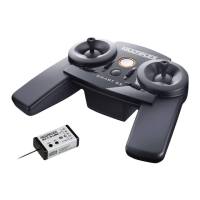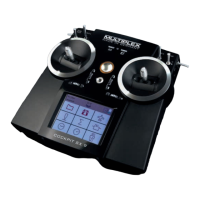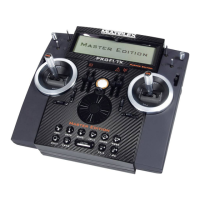Manual
55
Before using the system please read the appropriate
notes in the operating instructions supplied with the
speed governor.
13.9. Setting the collective pitch curve
I: takes effect in the active model memory.
Range: +/-100%.
One collective pitch curve for each flight phase.
F Any of the curve points can be allocated to a 3-D
digi-adjuster for in-flight adjustments (20.1.).
The collective pitch curve for model helicopters is set
up in the menu ¢Control under Collec.. A sepa-
rate collective pitch curve can be set up for each flight
phase, in order to obtain the most suitable form of col-
lective pitch control for each phase of flight:
Example 1: Collective pitch curve for the
flight phase HOVER
A “shallower” collective pitch curve from the hover set-
ting (stick centre) to the minimum setting (descent)
helps to provide fine control at the hover and promote
accurate landings.
In the “climb” area (stick centre to maximum) only 70%
of possible collective pitch travel is exploited. This
also contributes to fine control at the hover:
Example 2: Collective pitch curve for the
flight phase CRUISE
Linear, symmetrical collective pitch curve for the same
collective pitch control when climbing and descending:
13.10. Working with Flight phases
13.10.1. What is the purpose of switching between
different flight phases?
Using flight phases you can adjust the characteristics
of the transmitter controls to suit the requirements of
the model for each phase of flight (e.g. reduced travels
for HOVER, maximum control travels for collective pitch
at AUTOROTATION, V-shaped throttle curve for 3-D
flying, ...).
All settings which can be varied separately for the
flight phases are marked in the transmitter control
menus with the code number of the flight phase.
Example Roll control:
¢Aileron.HOVER
¨Exit
D/R – 80%
Trvl — 75%
Expo — -50%
Pre-condition: if you wish to work with flight phases,
you must assign at least one switch (for the main
phase, or phases 1-3) in the menu ¡, Assignment,
Switches. If this is not the case, the transmitter al-
ways remains in Phase 1.
!
Note: only transmitter control settings can be
altered
Settings which are flight phase specific can only be
entered in relation to the transmitter controls. The
servo settings remain the same for all flight phases.
13.10.2. Default settings in the menu Flight phase
Press button I: this opens the main menu Memory.
Now use the 3-D digi-adjuster to select the Flight
phase menu, and open it by pressing the 3-D digi-
adjuster.
A typical Flight Phase menu looks like this:
¦Flight phase
¨Exit
1 HOVER X ---
2 CRUISE ---
3 ACRO ---
4 AUTOROT ---
Time OFF
This provides us with the following information:
Flight phases 2, 3 and 4 are blocked (names crossed
though).
Names have already been assigned to all four pos-
sible flight phases, although they can be altered.
The three hyphens “---” following the flight phases in-
dicate that physical switches have not yet been as-
signed to operate as flight phase switches.
As a result Flight Phase 1 HOVER has automatically
been selected and marked as the active phase (X).
Same for all flight phases
For flight phase 2:
Travel = 75%
Expo = -50%

